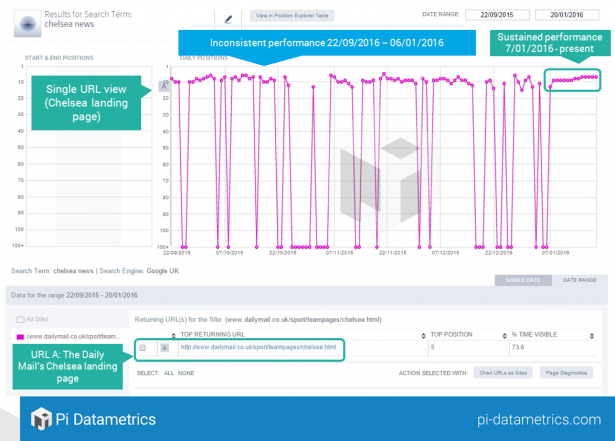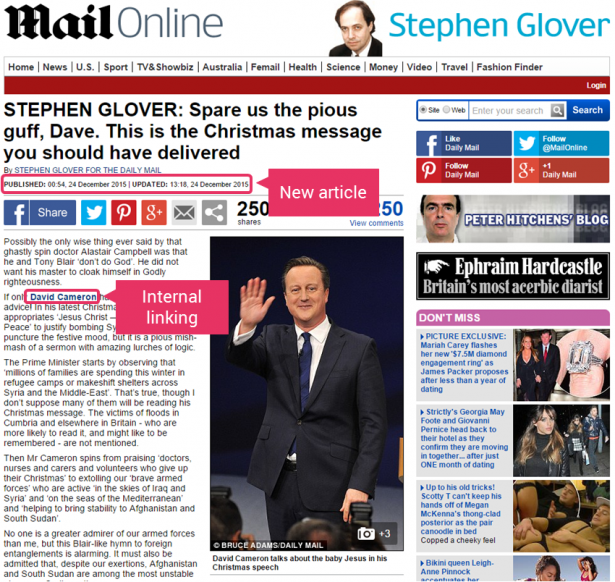Is an internal linking strategy paying off for Mail Online?
Combining hub pages for key topics with well-planned internal linking can be a very effective strategy to secure consistent search rankings for target keywords.
It’s become an essential tactic for publishers and others, especially when you are regularlycreating content around a particular topic.
The risk of producing a lot of content around the same topic is that you can end up with multiple pages which have similar keywords which compete against each other in Google for the same search terms.
For example, USA Today has ten different articles ranking for the term ‘Kylie Jenner’ during a six month period last year. As each new one comes along, it battles with the existing article, with the end result being a very inconsistent search performance.
The answer to this problem is to decide on a page that you want your site to rank for a given keyword or phrase, and concentrate on that. This hub, category or landing page (however you want to describe it) can then be the page that ranks for the term.
Sites can then consistently link to that page from new articles on the topic, eventually creating a useful resource, and one that stands a better chance of gaining high rankings than lots of individual pages.
One such example is the BBC’s Euro 2016 category page. Here it is:
It’s a repository for all of the site’s content around the tournament, and it ranks consistently.
It should also be noted that the groundwork for this was carried out well in advance of the start of Euro 2016 in early June so that, when the spike in interest around the term happened, the BBC was in position to attract plenty of traffic.
This is the BBC’s search rankings for the term ‘Euro 2016’ for the five months up to the start of the tournament. Nice and consistent.
This well planned use of hub pages along with consistent internal linking can really pay off. In the BBC’s case, it has ensured that its Euro 2016 page is in a great position to capitalise in increased interest from searchers around the tournament.
Of course, other factors have to be in place too. The BBC is an authority site with some excellent content and a formidable number of backlinks. Effective linking and theming will help any site, but other factors have to be in place to achieve high rankings for competitive search terms.
That said, it should not be beyond major publishers to profit from this strategy, and the example I’m going to use here is Mail Online. It is, by some accounts, the most visited English-language newspaper site on the web. Make of that what you will.
Mail Online and internal linking
Mail Online, until late last year, hadn’t been implementing a hub page / internal linking strategy at all.
We know this thanks to Dan Barker (@danbarker on Twitter) who pointed this out. He estimates that Mail started this strategy around October 25 last year.
Mail Online creates and publishes huge quantities of articles about celebrities and news. While each new article performs relatively well in search, they do so for a limited time only. So the article becomes old and search positions drop until the original article is usurped by a new article, and so on. This is where the proper strategy can help.
As we can see from the example below for the term ‘chelsea news’, ranking was inconsistent until early November 2015.
The chart shows search results for this term across the entire Daily Mail domain.
The consistent results post-November are for this hub page, which collates all the articles around that term.
Essentially, Mail Online has sent clear signals to Google, through (relatively) consistent internal linking, that this is the page it wants to rank for the term in question.
The hub page had existed before, but without the right linking strategy to promote it. Here we can seethe difference in performance before and after the Mail improved its linking strategy.
The charts above (all charts are from PI Datametrics btw) shows performance up to January 2016, but we can also see how it performed in the last six months.
The chart below shows the Daily Mail’s Chelsea landing page performance for the term ‘Chelsea news’.
Since January, there have only been 26 URL changes, and a lot steadier performance. The visibility for this page has improved as a result by 33.28% and this URL is visible for 98.1% of the time.
The chart below shows the hub / landing page’s performance. It’s mainly consistent, but shows that for the odd day or two, the page wasn’t visible.
This landing page hasn’t beaten its previous ranking of number five on Google.
The reason? Inconsistent linking. For maximum effectiveness, all mentions of the term on new articles should be linked back to the hub page. If this is not implemented, then newer pages can end up competing with the hub page for rankings. This is why it was visible for 98.1%, not 100% of the period shown.
Here’s another example, for the search term ‘David Cameron’. As the British PM (though not for much longer) he obviously attracts a lot of searches and mentions in the news.
This is the Daily Mail domain view for ‘David Cameron’. As with ‘chelsea news’, performance is inconsistent until November 2015.
After November, the Mail is linking to a landing /hub page more consistently (maybe the result of a staff training day on SEO?) and it has led to steadier rankings.
Here’s one example. It’s easy enough to implement.
However, as was the case with the previous example term, inconsistent linking means that Mail Online isn’t getting the full benefit.
Here’s a recent article mentioning David Cameron. No internal links.
Here’s the view of the David Cameron landing page for the past (almost) 12 months.
There’s been an increased number of URL changes, as newer pages compete with the hub page,but the overall visibility of this URL has improved and the ranking has increased by two positions.
Thanks to the EU referendum, there has obviously been a lot more content produced about David Cameron recently. Had the Mail linked consistently back to the landing page, this content would have been a lot more visible.
In summary: could do better
These examples show how effective the use of linking and hub pages can be, and demonstrate its value, especially for sites that produce a lot of content around the same themes.
They also demonstrate how quickly sites can achieve results with this strategy. However, consistent implementation is key for maximum effect.
That said, we can see how effective this strategy can be. When applied consistently across a range of popular terms, the result is higher and steadier rankings, putting the site in a position to attract more search traffic.










